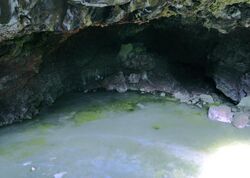Earth:Bandera Volcano Ice Cave
Bandera Volcano Ice Cave, also known as Zuni Ice Cave, is a lava tube cave in New Mexico with an internal temperature significantly less than above-ground summertime ambient temperature; it contains perennial ice.[1] The inside temperatures can fluctuate between −1 and 10 °C (31 and 50 °F). Some areas of the ice cave never reach above freezing. For years, local Indigenous people used the cave to store food.[1]
Geology
The lava tube was formed during the Bandera Crater eruption sometime between 9,500 and 10,900 years ago, during one of the many basaltic eruptions in the Zuni-Bandera volcanic field over the past million years.[2][3] The crater's cinder cone is 900-feet high reaching 8,309 feet above sea level.[4]
The eruption produced numerous formations in addition to lava tubes including a cinder cone, collapse pits, spatter cones and lava spine. The type of lava is ʻAʻā which is more viscous than pāhoehoe.[1] There are many lava tubes and several ice caves in the area including Giant Ice Cave.[4] One has been developed as a commercial ice cave near the Candelaria Trading Post.[3] Lava tubes in the area, "some dating back 115,000 years, formed a network of underground tubes stretching for 17 miles — the longest such system in the continental United States."[4]
Location
The cave system is located in the El Malpais lava field within the boundaries of El Malpais National Monument. The cave's location is N34° 59.556', W108° 04.926'.
Gallery
References
- ↑ 1.0 1.1 1.2 "Overview Geology References Pahoehoe Features Lava Tubes A-a Features & Ice Cave Cinder Cone Features of the Bandera Crater flow, Including Aa Lava & Ice Caves". New Mexico Bureau of Geology and Mineral Resources. https://geoinfo.nmt.edu/tour/federal/monuments/el_malpais/zuni-bandera/aa-ice.html. Retrieved 5 August 2020.
- ↑ Laughlin, A. William; Poths, Jane; Healey, Heather A.; Reneau, Steven; WoldeGabriel, Giday (1994-02-01). "Dating of Quaternary basalts using the cosmogenic 3He and 14C methods with implications for excess 40Ar". Geology 22 (2): 135–138. doi:10.1130/0091-7613(1994)022<0135:DOQBUT>2.3.CO;2.
- ↑ 3.0 3.1 "Geologic Background Zuni-Bandera Volcanic Field". New Mexico Bureau of Geology and Mineral Resources. https://geoinfo.nmt.edu/tour/federal/monuments/el_malpais/zuni-bandera/background.html. Retrieved 5 August 2020.
- ↑ 4.0 4.1 4.2 Benanav, Michael (28 August 2014). "Into a Lava-Lined Underworld Near Albuquerque". The New York Times. https://www.nytimes.com/2014/08/31/travel/into-a-lava-lined-underworld-near-albuquerque.html. Retrieved 5 August 2020.
[ ⚑ ] 34°59′30″N 108°04′58″W / 34.9916°N 108.0829°W
 |







